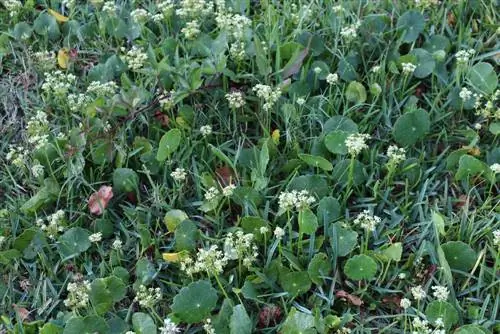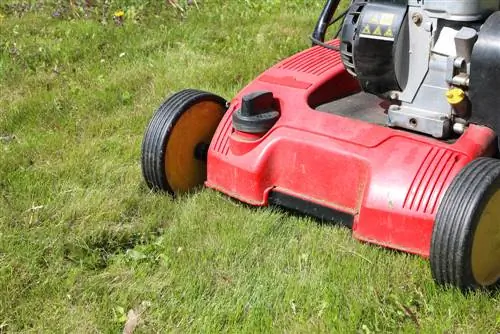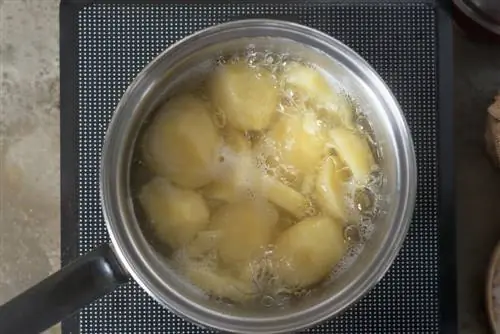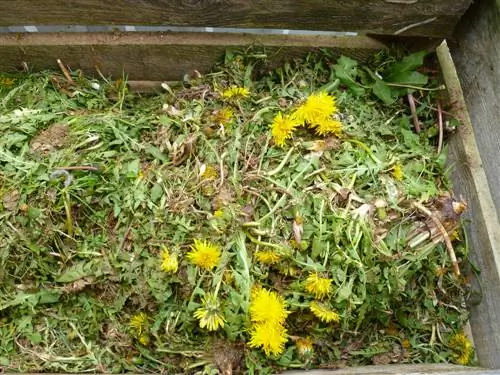- Author admin [email protected].
- Public 2023-12-16 16:46.
- Last modified 2025-06-01 06:02.
Creeping weeds in the lawn put our tolerance to wild herbs to the test. Rigorous control measures are required to ensure that groundweed, couch grass, groundweed and buttercup do not gain the upper hand in the green carpet. The correct approach depends on whether the gardener can name the weed. This guide explains how to correctly identify common lawn weeds and destroy them without using poison.
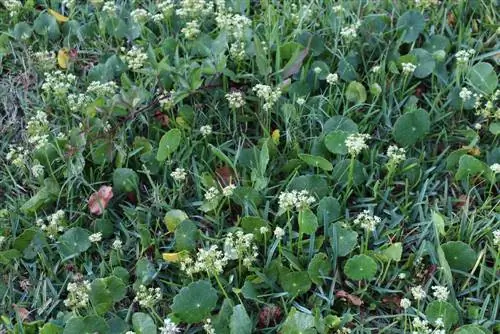
How do I remove creeping weeds from my lawn?
To successfully remove creeping weeds in the lawn, identify the plant species and remove them manually with a weed cutter or mechanically by scarifying. Annual weeds are controlled by regular mowing. Avoid herbicides as they are harmful to the environment and he alth hazards.
Top 10 creeping lawn weeds - identifying characteristics
Creeping weeds in lawns are characterized by prostrate growth with numerous, epically long runners. The undesirable plants owe their name to this property. Of course, this knowledge is not enough for a successful fight. If you want to successfully cross swords with the stubborn weeds, you should know the culprit by name. This listing reveals the 10 most common creeping lawn weeds with key identifying characteristics:
| Name | botanical name | Leaf shape | Growth length in cm | Flowers | Flowering time | annual/perennial |
|---|---|---|---|---|---|---|
| Gundermann | Glechoma hederacea | kidney-heart-shaped, notched, hairy | 10-50 | blue-purple bell flowers | April to July | perennial |
| Giersch | Aegopodium podagraria | ovoid, tripinnate, serrated | 30-100 | white, flat umbels | June to July | perennial |
| Crawling Gunsel | Ajuga reptans | ovoid, shiny on top | 10-30 | blue, pink, white mock whorls | April to June | two-year-old |
| Creeping Buttercup | Ranunculus repens | three-pinnate, toothed | 10-50 | golden yellow, fivefold | May to September | perennial |
| Little Brownelle | Prunella vulgaris | elliptical, notched, evergreen | 5-30 | blue-violet, five-fold, goblet-shaped | June to October | perennial |
| Meadow clover | Trifolium pratense | fingered in three parts | 15-60 | red ball flowers | April to October | one to two year old |
| White Clover | Trifolium repens | fingered in three ways | 5-30 | white ball flowers | May to September | perennial |
| chickweed | Stellasia media | ovoid tapering | 3-40 | white star flowers | May to October | annual |
| Thread Honor Award | Veronica filiformis | round, small | 10-50 | sky blue | March to June | annual |
| hornwort | Cerastium | elongated to round | 5-30 | many colors | April to September | annual or perennial |
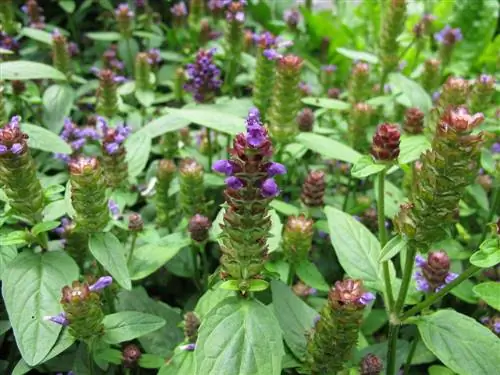
The Little Brownelle crawls quietly and secretly through the lawn
Primarily the shape of the leaves reveals which creeping weeds are taking over your lawn. Flower shape and color also provide meaningful information. If this table has put you on the right track, consult the relevant article on Wikipedia. Here you can read important identifying features, such as the arrangement of the leaves, coloring of the leaves above and below, flower shape and flower color.
As this table shows, perennial species dominate the top 10 creeping lawn weeds. Unfortunately, with Gundermann and the like, you have to deal with extremely stubborn rivals. Annual weed species give up more quickly and can be dismissed using simple control methods.
The futility of human actions is revealed in the fight against Giersch and Gundermann.
Destruct perennial, creeping lawn weeds
The most promising control strategy against perennial, creeping lawn weeds depends on the stage of infestation. In the early stages with local weed nests, a different approach makes sense than when they spread over a large area over the entire lawn. Below, a tried-and-tested step-by-step guide is dedicated to both variants. How to successfully combat creeping weeds in the lawn:
Manually combat isolated weeds

Scattered weeds can best be removed by hand
The aim of manual control is to completely remove the mother plant and its long runners from the lawn. Pulling weeds out of the ground by hand only achieves short-term success. Tiny root remnants are enough for new shoots. Instead, pick up a weed whacker. Use the V-shaped shovel to penetrate deep into the turf to lift all the roots out of the ground. Use the weed cutter to follow the runners to the end and lift them out of the lawn together with their short root strands.
The tried and tested method is less strenuous if the lawn is well moistened. You can do this in a way that is gentle on your back using a weed cutter from Fiskar (€42.00 on Amazon) or Gardena. The functional principle is based on a combination of handle and gripping knives, which makes annoying bending unnecessary.
Destruct extensive lawn weeds mechanically
If creeping weeds spread over a large area in the lawn, you are fighting a losing battle with a weed cutter. Get a scarifier as a mechanical defense aid to combat goosegrass, groundworm and other meandering wild weeds. How to properly scarify to remove creeping weeds from the lawn:
- Mowing the lawn
- Set scarifier to 3 mm cutting depth
- Place the device on the lawn and switch it on
- scarify a path, switch off the device and check the result
- If necessary, modify the cutting depth to 4 mm, maximum 5 mm
- comb out weedy lawn lengthwise and crosswise (checkerboard pattern)
- sweeping combed out thatch with weeds
- Care: do not dispose of in the compost, but take it to the nearest landfill or composting facility
- mow again after scarifying and sweeping away
Where perennial, creeping weeds are destroyed, they leave small or large gaps in the lawn. Since Gundermann, Giersch or Günsel sprout from even the tiniest root residues, you should give the lawn grasses a growth advantage. You can do this by repairing open areas of lawn and reseeding them. By the time creeping weeds have recovered from the control measure and can make a new attempt, vital lawn grasses have gathered to form a dense, green bulwark and suppress weed growth.
Excursus
Hands off herbicides
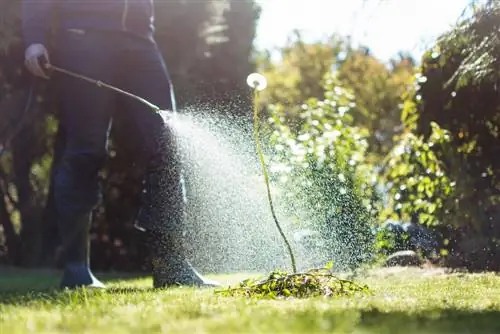
Herbicides should definitely be avoided in the garden
The persistence of perennial lawn weeds can infuriate those affected. Anyone who wields chemical cudgels while suffering from Gundermann, Giersch and dandelions is doing a disservice to he alth, the environment and nature. Glyphosate and other chemical herbicides are under reasonable suspicion of being carcinogenic and partly responsible for the death of insects. In practical use, chemical weed killers have been shown to destroy all life in the lawn, apart from creeping perennial weeds.
Fighting annual creeping lawn weeds
Annual, creeping lawn weeds mostly grow as seed weeds. Chickweed or thread speedwell has a single season available for germination, growth, flowering, seed formation and self-seeding. The seeds can survive in the soil for many years and retain their ability to germinate. Weed seeds often nest under the sod when new grass is planted or are carried by the wind onto the lawn. Unfortunately, when you scarify the lawn to combat perennial weeds, the wild seeds get deeper into the ground. There the long-lasting seeds cunningly wait for ideal conditions.
The rule of thumb for successful control is: Do not allow annual, creeping weeds to bloom in the lawn. The plan works by mowing the lawn weekly from spring to fall. Do not allow more than 5 to 7 days to pass between appointments. This period is far too short for seed formation and germination. Furthermore, in the long run you are losing the edge of the wild herbs, so that their growth potential is weakened.
Tip
Proper mowing supports the lawn in the silent fight against creeping weeds. Do not cut the noble grasses back deeper than 4 centimeters. Thanks to this blade height, lawn grasses cast permanent shade on weed seeds and creeping weed tendrils. This suppresses germination and stops photosynthesis, which effectively slows down invasive spread in the lawn.
Frequently asked questions
What is the main cause of creeping weeds in the lawn?

Nutrient deficiency is often the reason for weeds in the lawn
Nutrient deficiency is the most common cause of the invasive spread of creeping lawn weeds. The noble grasses of the lawn require a significantly higher quantity of nutrients than Gundermann and Co. If there is a lack of nutrients in a green area, weeds take advantage of the opportunity and overgrow the weakened grass. Annual fertilization in spring and autumn strengthens the growth of noble lawn grasses so that they can suppress creeping competition on their own.
Creeping yellow weeds are spreading through my lawn. What is that? How do I deal with this?
From your description it appears that creeping buttercup (Ranunculus repens) has settled in your lawn. This is a yellow-flowering weed with a stubborn tendency to spread. Unfortunately, the common lawn weed multiplies via deep roots, long runners and countless seeds at the same time, which makes combating them a nerve-wracking challenge. Consistently dig each specimen deeply to get all the root strands. Mowing the lawn regularly keeps self-seeding under control.
Numerous field thistles spread through the lawn and make walking barefoot impossible. What to do?
With its prickly, creeping tendrils, the field scratch thistle is one of the feared lawn weeds. You can take advantage of a growth characteristic of the prickly plants for effective control without chemical herbicides. Thistles have hollow stems. Always mow when the weather forecast calls for rain. With the rain, water penetrates deep into the stems and causes the weeds to rot. Alternatively, spray the lawn after mowing.
How can you destroy creeping weeds in the lawn without strenuous weeding, laborious scarifying and toxic herbicides?
A convenient control method cuts off creeping lawn weeds from access to sunlight, so photosynthesis comes to a standstill. For this purpose, cover weed-infested areas of lawn with black foil. Fasten the edges of the film with stones or gravel. It takes about two months for the weeds under the film to die off. Now you can remove the foil. Shovel off the top layer of soil and spread a mixture of sifted compost and sand as a seed bed, which you press down with a roller or your hands. Now sow fresh lawn seeds and water with a fine spray.
Tip
An imaginative garden design without a lawn puts an end to the grueling battle against creeping weeds. Floral beauties such as star moss (Sagina subulata), Roman lawn chamomile (Anthemis nobilis v. ligulosa) and cushion thyme (Thymus citriodorus) are the creative alternative to the monotonous lawn monotony. The golden yellow buttercups of creeping buttercups, cinquefoil and other creeping plants that are unfairly maligned as weeds are also welcome here.

